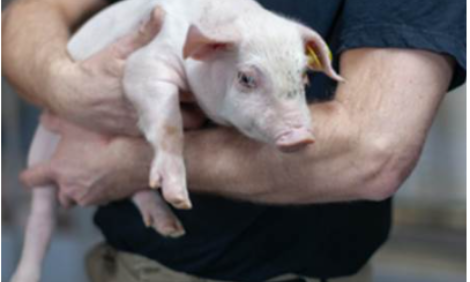



Blood Poisoning – What you Need to Know This Spring
By Western Swine Health Associates - Drs. Frank Marshall, Chris Misutka, Pete Pawluk, Gail Cunningham, published by Alberta Pork in their Spring 2004 Western Hog Journal.
Spring is once again upon us and along with the melting snow we are getting those great temperature and weather fluctuations we know so well. Along with the promise of spring comes the promise of increased amounts of septicemia (blood poisoning) in our barns. The following article is a summary of the factors that contribute to septicemia, diagnosis, treatment and appropriate preventative measures that all producers need to address as part of their herd health program.
Blood Poisoning or Septicemia is defined as the presence of pathogenic bacteria living and multiplying in the blood. If it is allowed to progress can cause overwhelming infection and death. There are varying degrees of septicemia depending on the bacteria involved, immune status of the pig, environment and many other factors that will be discussed. We can see symptoms that range from signs of mild pneumonia and depression to sudden death with virtually no signs preceding it. Severe septicemia can kill hundreds of pigs in a short period of time and leave behind many chronic poor doers. It is an economically important disease that all producers need to understand and address in their herds.
Understanding Health Definitions
High health herds are free from Atrophic Rhinitis, Mycoplasma, APP, TGE, PRRS, Mange and Swine Dysentery. The diseases that can remain in high health herds include E.coli, Erysipelas, Parvovirus, Circovirus, Ileitis, Glasser’s, Streptococcus suis and Clostridial diseases. Virtually all herds have blood poisoning organisms such as Strep, Glassers and E.coli in them. High health is not freedom from disease; it is freedom from specific diseases.
The “Suis-ide” or blood poisoning bacteria that we commonly deal with are Strep. suis, Glassers, E.coli, Actinobacillus suis and Erysipelas. Strep and Glassers are passed from the sow to the piglets where they colonize in the tonsil. The tonsilar colonization or ‘seeding’ of piglets means that they carry the bacteria but do not get sick unless they are placed under stress or some precipitating factor. There are more than 30 different types of Strep suis and more than 12 different types of Glassers bacteria. Each barn or system will have its own strain that the pigs are normally exposed to. However, when pigs from different sources are mixed that are carrying different strains we often get disease expressed. This is another reason why multiple sourcing of pigs can cause serious problems.
Precipitating Factors that Can Lead to Blood Poisoning
Although these bacteria are present in the herd, they do not always cause disease. There are a host of other factors involved besides the presence of the bacteria that lead to us seeing the disease in the barn. By controlling these precipitating factors we can often reduce the number of blood poisoning cases we see. It is what we call a ‘multifactorial disease’, meaning there are many factors that can contribute to the disease being expressed or seen in the herd. It is these pre-disposing factors that must be addressed in any outbreak of blood poisoning.
1. Temperature Fluctuation - A change in temperature of greater than 2 to 3 degrees is perceived as a chill to a pig, especially in the nursery area. Drafts due to high air speed from open fans and inlets can also cause chilling. Nursery pigs especially need a comfort zone where there is appropriate temperature, freedom from any drafts and a dry place to lie. If the pigs are damp due to high humidity, it will take even less of a change in temperature or draft to cause chilling and precipitate illness. Spring and fall tend to be the worst time of year for septicemia due to the great variations in temperature from day to night and day to day. Sundown can lead to a sudden drop in barn temperature leading to more septicemia cases during these periods of the year
2. Mixing - Mixing pigs from different sources leads to stress from fighting, changes in environment etc., all of which lead to shedding of blood poisoning organisms. As mentioned earlier, pigs from different sources will have different strains of Strep and Glasser’s as well as different E.coli, A. suis and other organisms. This exchange can lead to outbreaks of disease as the pigs are exposed to bacteria they do not have adequate immunity to. Multiple sourcing of pigs can lead to different strains of bacteria being shared and serious illness in one or all of the groups can result. Mixing of pigs that are negative for one of these Suis-ide bacteria with animals that have it will also result in illness and possible death for the negative animals. It is important to understand the health status of the source of any purchased animals entering your barn.
Mixing pigs of different ages in continuous flow systems also allows for greater spread of septicemic organisms. The older pigs can be shedding bacteria, increasing the amount that the younger pigs are exposed to.
3. Weaning Time Stress -Weaning time is extremely stressful for piglets and can precipitate disease. They are removed from the sow, mixed, change environments and change feeds all at once. We need to ensure that they are going on to a highly digestible diet, that the room is warm enough and draft free, that they have a good comfort zone to sleep in and that they are medicated appropriately if needed. Putting these babies into cold (<28 degrees), drafty rooms or on inappropriate diets for age can all precipitate disease.
4. Start Up or Large Numbers of Gilt Litters - Gilts typically do not have as high quality colostrum as mature sows. They have not been exposed to as many pathogens and do not produce the same level of antibodies to pass on to their offspring. Likewise, the colonization or ‘seeding’ process is significantly reduced in gilt litters resulting in negative animals in the nursery. This means we tend to see more blood poisoning cases as their offspring move through the barn. We also tend to see more diseases such as Greasy Pig for the same reason.
5. Lactation Length - In instances requiring groups to be early weaned due to overbreeding and/or missed breeding targets, the shorter lactation length will also reduce the ‘Suis-ide’ bacterial colonization. This reduced colonization also leaves many susceptible piglets in the nursery similar to the situation for the gilt litters.
6. Overcrowding - Overcrowding is stressful to the pig in that they do not have adequate room for comfort and it can limit access to feed and water.
7. Inadequate Ventilation and High Humidity - Low ventilation rates and increased humidity will both increase the number of bacteria that survive in the airspace. Bacteria love warm, moist environments and have an increased ability to survive and multiply in them. Low ventilation rates reduce the amount of fresh air exchanged in the barn and increase the amount of potentially bacteria laden air. It is important to maintain some minimum ventilation even in winter to remove excess humidity and stale air. On the other hand, excessive ventilation rates can lead to drafts and chilling so they must be appropriate for the age of pig.
8. Change or Removal of Medication - When animals are mixed at weaning or from different sources and disease results, it is important to culture the bacteria and get an antibiotic sensitivity for it. This allows the producer to match preventative medication needs with the susceptibility pattern of the bacteria. Changing medications without veterinary and lab consultation can lead to inappropriate choices for the bacteria present and medication failure. It is always important to know what bacteria you are dealing with and match the medication to it.
9. Virulence of the organisms - The virulence or “strength” of the organism plays a very important role in the type of disease you may see. Some strains of bacteria cause more severe disease than others. Different strains of the Glasser’s bacteria can cause anything from swollen joints to sudden death with no signs. The virulence of the particular organism and the immune status of the pig to that particular organism will affect the signs you will see in the barn.
10. Concurrent Disease in the Herd – If there is other significant disease in the herd, such as a new outbreak of PRRS or scours, the pig will be more susceptible to blood poisoning organisms. The immune system can simply become overloaded and unable to cope with several challenges at once.
Signs and Symptoms
The signs of blood poisoning vary greatly depending on many of the above factors. The following is a summary of some of the signs you may see as well as some photographs of different expressions of blood poisoning.
1. Sudden Onset of Fever -Signs may include loss of appetite and therefore reduced feed intake, depression where pigs dog sit or lay in the pen and do not get up and move when the pen is disturbed and possible shifting lameness.
2. Purple Ears - Due to disruption of circulation from the blood poisoning.
3. Swollen Joints - May appear at less than 10 days of age or following a reduction in feed intake. This may be the only sign of blood poisoning in some barns.
4. Red, Blotchy Skin - These patches will be diamond shaped with Erysipelas
5. Nervous System Signs:
In-coordination where pigs appear ‘Drunk’
Unusual posture or stance in the pen due to loss of balance or lameness
Inability to stand
Head tilt - due to middle and inner ear infection from blood poisoning that has localized into the ear.
Convulsions where pig cannot stand even if helped and head is pulled back into an unusual position. The legs will often ‘paddle’ at the same time and the eyes will move back and forth rapidly.
Pig lying very still and ‘staring’ even when moved or disturbed.
6. Fading Pigs - Pigs become chronic poor doers and start to fade about 8 to 10 days after weaning
7. Respiratory Signs - Ranging from increased respiration rate, coughing and depression to chronics that become ‘thumpers’ and breathe very hard due to heart failure from the infection.
8. Sudden, Acute Death - This happens in all ages of pigs that are susceptible to the organism. It is more common pre-weaning and in the nursery. However, we have recently seen several outbreaks with hundreds of pigs lost due to pure septicemia in grower and finisher age animals as well as replacement gilts. There is no age cut off for severe septicemia.
To continue reading this article please Click Here
(Western Hog Journal Spring 2004)








